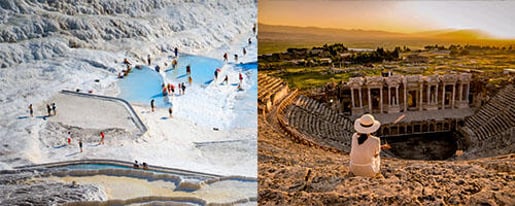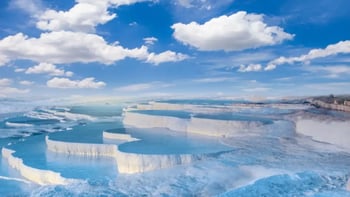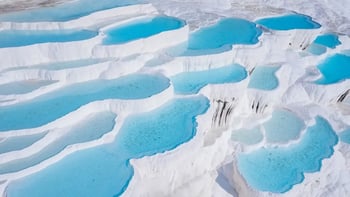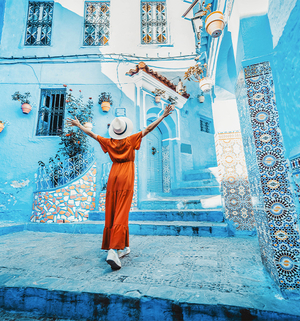Explore Pamukkale and Hierapolis
Pamukkale and the ancient city of Hierapolis together form one of Turkey’s most iconic UNESCO World Heritage Sites. Known as the “Cotton Castle,” Pamukkale’s white travertine terraces, shaped by thermal waters, have been a natural spa destination since Roman times.
Visitors can walk across the gleaming terraces, soak in mineral-rich pools, and enjoy breathtaking views of the valley. Just above, Hierapolis invites you to step into history with its well-preserved Roman theatre, ancient streets, temples, necropolis, and the famous Cleopatra’s Pool.
A visit to Pamukkale and Hierapolis is a journey through natural wonders and ancient heritage — a perfect blend of relaxation, history, and beauty.
Pamukkale and Hierapolis History
Pamukkale, meaning “Cotton Castle,” has been a natural wonder for thousands of years. Its striking white travertine terraces were formed by calcium-rich thermal waters flowing down the hillside, creating one of the world’s most unique landscapes. Since antiquity, these mineral springs have been famed for their healing properties, attracting visitors from near and far.
Just above the terraces lies Hierapolis, a Greco-Roman city founded in the 2nd century BC. It flourished as both a cultural hub and a spiritual healing center, thanks to its sacred hot springs. With its grand theater, temples, and monumental gates, Hierapolis reflected the sophistication of Roman urban life.
Throughout Byzantine times, the site remained significant, especially with the construction of churches and the belief that it housed the tomb of the Apostle Philip. Today, Pamukkale and Hierapolis stand together as a UNESCO World Heritage Site, blending breathtaking natural beauty with layers of ancient history.
Why Visit Pamukkale and Hierapolis?
Historical Significance: Hierapolis was founded in the 2nd century BC and became a thriving Greco-Roman and Byzantine city. Its sacred hot springs and monumental structures reflect its role as both a healing center and a place of worship.
Natural Beauty: Pamukkale’s dazzling white travertine terraces, formed by calcium-rich waters, create one of the most unique landscapes in the world. These “Cotton Castle” formations are a natural wonder admired for centuries.
Architectural Marvels: From the well-preserved Roman theater and the Temple of Apollo to Byzantine churches and ancient necropolises, Hierapolis offers a stunning showcase of classical architecture.
Spiritual Heritage: The site is home to the Martyrium of St. Philip, believed to mark the tomb of the Apostle Philip, making it an important pilgrimage site for early Christians.
UNESCO World Heritage Site: Recognized for both its cultural and natural significance, Pamukkale and Hierapolis offer an unparalleled experience blending history, spirituality, and breathtaking scenery.
Things to Know Before Booking Pamukkale & Hierapolis Tickets
Ticket Types Explained:
- Skip-the-Line Ticket: Covers entry to both Pamukkale’s terraces and the ancient city of Hierapolis.
- Audio Guide Ticket: Provides rich insights in English, guiding you through the site at your own pace (entry ticket not included).
Online vs. Onsite: Why Book Pamukkale Tickets Online?
Booking online ensures fast-track entry, especially during peak season. Same-day tickets are emailed immediately; for future visits, tickets are delivered the day before. Online bookings often include extras like audio guides.
Skip-the-Line Options:
- Entry ticket with audio guide — priority entry plus detailed commentary.
- Flexible tickets for terraces + Hierapolis ruins, with the option to add Cleopatra’s Pool entry onsite.
Tips for Avoiding Queues:
- Book in advance to skip lines.
- Visit early morning or late afternoon for fewer crowds.
- Bring a fully charged phone and headphones if using the audio guide.
Pamukkale & Hierapolis Highlights
Pamukkale & Hierapolis is a unique blend of natural wonder and ancient history, offering visitors unforgettable sights that showcase both geological beauty and cultural heritage. Here are the key highlights you shouldn’t miss when exploring this UNESCO World Heritage Site.
Travertine Terraces: The dazzling white calcium terraces of Pamukkale, nicknamed the “Cotton Castle,” are one of Turkey’s most iconic natural wonders. Formed by mineral-rich hot springs, these cascading pools have been admired and used for healing since Roman times.
Roman Theater: A grand structure seating over 12,000 people, the theater of Hierapolis is one of the best-preserved in Asia Minor. It once hosted dramatic performances, religious ceremonies, and imperial events, showcasing the city’s importance in Roman society.
Temple of Apollo & Plutonium: Central to Hierapolis’s spiritual life, the Temple of Apollo honored the sun god, while the nearby Plutonium was believed to be an entrance to the underworld. These sacred sites reveal the deep religious traditions of the ancient city.
Martyrium of St. Philip: A striking Byzantine monument, this octagonal structure is believed to be the burial site of the Apostle Philip. It became a major Christian pilgrimage destination, symbolizing the city’s role in early Christianity.
Necropolis: Stretching for nearly 2 km, the necropolis of Hierapolis is one of the largest ancient cemeteries in Turkey. It contains hundreds of sarcophagi, monumental tombs, and mausoleums, offering insights into burial customs and the city’s social history.
Cleopatra’s Pool: Also known as the Antique Pool, this thermal spring invites visitors to bathe among submerged marble columns from antiquity. Warm, mineral-rich waters and ancient ruins combine for a one-of-a-kind experience.
Compare Your Pamukkale & Hierapolis Ticket Options
Pamukkale & Hierapolis Maps
Located in Denizli province, Pamukkale sits just above the Menderes River Valley. The site combines natural terraces with the ruins of Hierapolis, making it both a geological and archaeological wonder.
The entrance is about 20 km from Denizli city and can be reached by bus, car, or guided tour.
📍 Map Link: Pamukkale & Hierapolis on Maps
Plan Your Visit to Pamukkale & Hierapolis
Timing & Duration:
- Open daily: Summer (Apr–Oct): 06:30 – 21:00 / Winter (Nov–Mar): 06:30 – 19:00.
- Most visits last 3–4 hours; add 1 hour if swimming in Cleopatra’s Pool.
Location & How to Reach:
- By Air: Denizli Çardak Airport, 65 km away.
- By Bus: Frequent minibuses run from Denizli to Pamukkale.
- By Car: Accessible from Izmir (3 hrs), Antalya (3.5 hrs), Kusadasi (2.5 hrs).
- By Tour: Daily tours available from Antalya, Kusadasi, Bodrum, and Izmir.
Accessibility Information:
Due to uneven surfaces, accessibility is limited. Some paths and ruins are challenging for wheelchairs or strollers.
Facilities (Restrooms, Cafes, ATMs):
Restrooms, cafes, and small shops are available near entrances and inside the site.
Visitor Tips (Do’s & Don’ts):
- Do remove shoes when walking on travertines.
- Do carry water, sunscreen, and a hat in summer.
- Don’t swim in the terraces — only in designated pools.
- Don’t enter restricted areas marked for conservation.
Shopping: Souvenir shops in Pamukkale village sell local crafts, cotton textiles, and stone carvings.
Dining Options: Cafes and restaurants in Pamukkale village offer Turkish dishes; some overlook the travertines.
Where to Stay Nearby: Pamukkale village offers boutique hotels and pensions. For more variety, Denizli city has mid-range and business hotels.
Explore Beyond Pamukkale & Hierapolis
While Pamukkale & Hierapolis are unmissable highlights, Turkey offers many other remarkable destinations to explore — each rich in history and beauty:
Ephesus Ancient City Tickets: Walk in the footsteps of St. Paul and explore Roman marvels like the Library of Celsus.
Cappadocia Tours & Museums — Discover the magical landscapes of Cappadocia, from fairy-chimney valleys to rock-cut churches at the Göreme Open-Air Museum. Explore underground cities and experience the region’s rich cultural and religious heritage.
Antalya City Tours — Journey to the Turkish Riviera, where golden beaches meet ancient ruins and Ottoman charm. Explore Kaleiçi’s winding streets, visit Hadrian’s Gate, and enjoy breathtaking views of the Mediterranean.
Whether you’re drawn to natural wonders, ancient ruins, or vibrant cultural landscapes, Turkey’s treasures extend far beyond Pamukkale — offering unforgettable journeys through time and tradition.
Pamukkale & Hierapolis Opening Hours
- Summer (Apr–Oct): 06:30 – 21:00
- Winter (Nov–Mar): 06:30 – 19:00
- Last entry: 1 hour before closing.
How to Get to Pamukkale & Hierapolis
Public Transport: Minibuses from Denizli bus station run every 30 minutes.
By Air: Denizli Çardak Airport connects with Istanbul and Ankara.
By Car: Easily accessible via D320 highway.
By Tour: Full-day guided tours available from nearby cities.
Need to Know About Pamukkale & Hierapolis
Audio Guides: Visitors can explore Pamukkale and Hierapolis with a self-guided audio tour.
Shoes: Walking barefoot is mandatory on the travertine terraces to protect the natural formations. Bring a bag to carry your shoes. Wear comfortable footwear for exploring Hierapolis, as the archaeological site covers a large area.
Dress Code: No specific dress code applies, but lightweight clothing, hats, and sun protection are recommended. Swimwear is useful if you plan to bathe in the thermal pools.
Thermal Pools Access: Entry to Cleopatra’s Antique Pool (Sacred Pool) requires a separate ticket, not included in standard admission.
Facilities
- Audio Guide: Available in English, downloadable for offline use.
- Food: Cafes and restaurants in Pamukkale village serve Turkish meals and snacks.




Pamukkale & Hierapolis Reviews
So nice. No line nice weather great place
Smooth process. The terraces are beautiful like a dream. Audio guide made the ruins more interesting
Was easy to find the entrance. I am not good with tech but audio guide was simple and work fine. The view is amazing
Perfect day. The instructions were clear the ticket worked right away and I liked learning the small details about Hierapolis. Comfortable shoes and water are important
We came in the morning and went straight inside. No stress about tickets. The guide explained things in a simple way so even my kids listened for a bit. Loved both the pools and the ruins